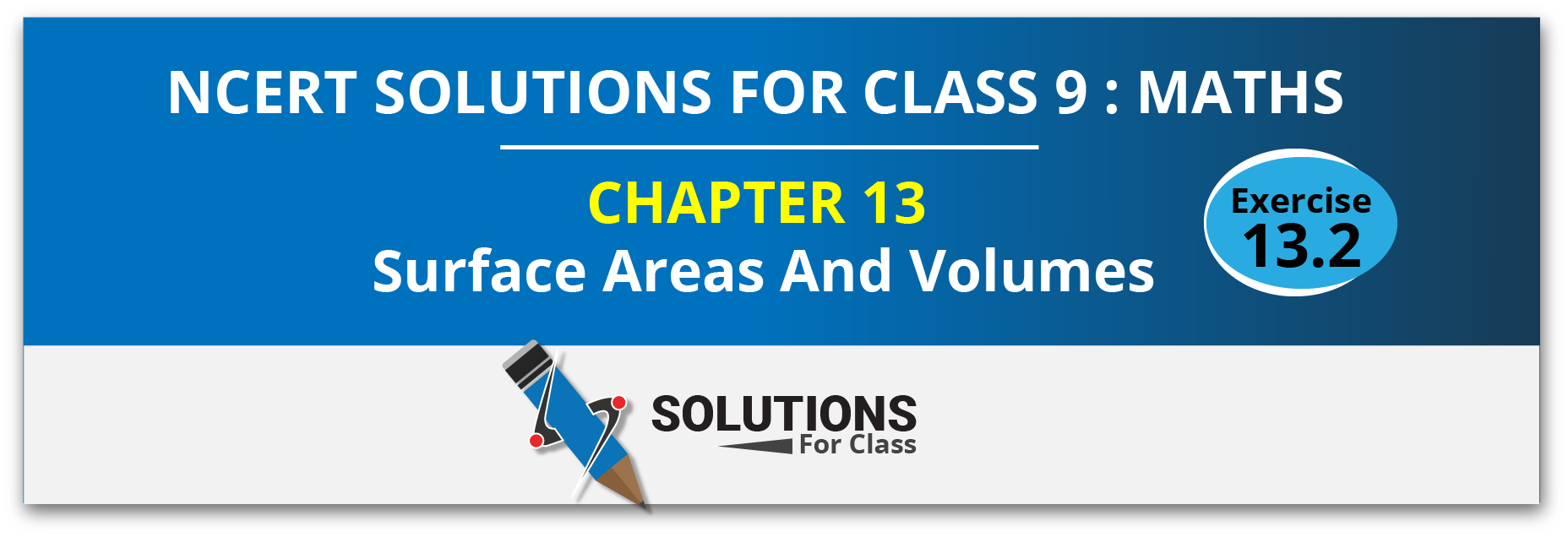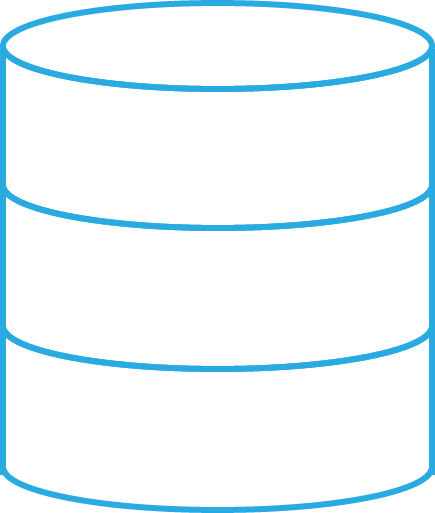NCERT Solution For Class 9, Maths, Chapter 13, Surface Areas And Volumes, Exercise 13.2 involves questions related to curved surface area of cylinder with the formula. Class 9 , maths chapter 13 , Ex13.2 consists of total 11 questions to study. all questions are formula based which are given below.
Table of Contents
Toggle
Class 9, Maths, Chapter 13, Exercise 13.2 Solutions (Page no. 216)
Q.1. The curved surface area of a right circular cylinder of height 14 cm is 88 cm2. Find the diameter of the base of the cylinder.
Ans: Let r be the radius of the base and h = 14 cm be the height of the cylinder. Then, Curved surface area =
⟹ $88=2\times \frac{22}{7}\times r\times 14$
⟹ $r=\frac{88\times 7}{2\times 22\times 14}=1$ cm
Diameter of the base = 2r
⇒ 2 × 1= 2 cm
Hence, the diameter of the base of the cylinder is 2 cm.
Q.2. It is required to make a closed cylindrical tank of height 1 m and base diameter 140 cm from a metal sheet. How many square metres of the sheet are required for the same?
Ans: Let r be the radius of the base and h be the height of the cylinder.
Metal sheet required to make a closed cylindrical tank = Its total surface area
= 2πr (h + r)
= 2 × 22/7 × 0.7 (1+ 0.70) m2
[∵ h =1m, r =140/2 cm = 70 cm =0.70 m]
= 2 × 22 × 0.1 × 1.70 m2
= 7.48 cm2
Hence, the sheet required is 7.48 m2
Q.3. A metal pipe is 77 cm long. The inner diameter of a cross section is 4 cm, the outer diameter being 4.4 cm in the given figure. Find its
(i) inner curved surface area,
(ii) outer curved surface area,
(iii) total surface area.
![]()
Ans: We have, R = external radius =$\frac{4.4}{2}$ cm = 2.2 cm
r = internal radius = $\frac{4}{2}$ = 2 cm
h = length of the pipe = 77 cm
(i) Inner curved surface = 2πrh
= $2\times \frac{22}{7}\times 2\times 77\,\,c{{m}^{2}}$
= 968 cm2
(ii) Outer curved surface =
= $2\times \frac{22}{7}\times 2.2\times 77\,\,c{{m}^{2}}$
= 1064.8 cm2
(iii) Total surface area of a pipe
= Inner curved surface area + outer curved surface area + areas of two bases
= 2πrh + 2πRh + 2π (R2 – r2)
= 968 + 1064.8 + $2\times \frac{22}{7}\times \left[ {{(2.2)}^{2}}-{{(2)}^{2}} \right]$
= 2032.8 + $\frac{44}{7}\times \left[ 4.84-4 \right]$
= 2032.8 +(44 x 0.12)
= 2032.8 + 5.28
= 2038.08 cm2
Q.4. The diameter of a roller is 84 cm and its length is 120 cm. It takes 500 complete revolutions to move once over to level a playground. Find the area of the playground in m2.
Ans: The length of the roller is 120 cm i.e., h = 1.2 m
and radius of the cylinder (i.e., roller) = $\frac{84}{2}$cm = 42 cm = 0.42 m.
Distance covered by roller in one revolution = Its curved surface area
= 2πrh
= (2 × $\frac{22}{7}$× 0.42 ×1.2) m2
= 3.168 m2
Area of the playground = Distance covered by roller in 500 revolutions
= (500 × 3.168) m2 = 1584 m2
Q.5. A cylindrical pillar is 50 cm in diameter and 3.5 m in height. Find the cost of painting the curved surface of the pillar at the rate of ₹12.50 per m2.
Ans: Let r be the radius of the base and h be the height of the pillar
∴ r = $\frac{50}{2}$ cm = 25 cm = 0.25 m and h = 3.5 m
Curved surface = 2πrh
= (2 × × 0.20 × 3.5) m2
= 5.5 m2
Cost of painting the curved surface @ ₹ 12.50 per m2
= ₹ (5.5 ×12.5) = ₹ 68.75
Q.6. Curved surface area of a right circular cylinder is 4.4 m2. If the radius of the base of the cylinder is 0.7 m, find its height.
Ans: Let r be the radius of the base and h be the height of the cylinder. Then,
Curved surface area = 4.4 m2
⇒ 2πrh = 4.4
⇒ (2 × × 0.7 × h) = 4.4 [∵ r = 0.7 m]
⇒ h = = 1m
Thus, the height of the cylinder = 1 meter.
Q.7. The inner diameter of a circular well is 3.5 m. It is 10 m deep. Find
(i) its inner curved surface area,
(ii) the cost of plastering this curved surface at the rate of ` 40 per m2.
Ans: (i) Let r be the radius of the face and h be depth of the well. Then,
Curved surface area = 2πrh
⇒ $\left( 2\times \frac{22}{7}\times \frac{3.5}{2}\times 10 \right)$ m2 = 110 m2
(ii) Cost of plastering is ₹ 40 per m2
∴ Cost of plastering the curved surface = ₹ (110 × 40) = ₹ 4400.
Q.8. In a hot water heating system, there is a cylindrical pipe of length 28 m and diameter 5 cm. Find the total radiating surface in the system.
Ans: Total radiating surface in the system
= Curved surface area of the pipe
Where $r=\frac{5}{2}cm=2.5cm=\frac{2.5}{100}m=0.025\,m$ and h = 28 m
⇒ $\left( 2\times \frac{22}{7}\times 0.025\times 28 \right)$ m2 = 4.4 m2
Q.9. Find : (i) the lateral or curved surface area of a closed cylindrical petrol storage tank that is 4.2 m in diameter and 4.5 m high.
(ii) how much steel was actually used, if of the steel actually used was wasted in making the tank.
Ans: (i) Here, $r=\frac{4.2}{2}m=2.1\,\,m$ and h = 4.5 m
Lateral surface area = 2πrh
⟹ $\left( 2\times \frac{22}{7}\times 2.1\times 4.5 \right){{m}^{2}}$
= 59.4 cm2
(ii) Since $\frac{1}{12}$of the actual steel used was wasted, the area of the steel which has gone into the tank = $\left( 1-\frac{1}{12} \right)$of x = $\frac{1}{12}$ of x.
Steel used = (2πrh+ 2πr^2) cm^3
= (59.4 + 2 × × 2.1 × 2.1) cm2
= (59.4 + 27.72) cm = 87.12 cm2
∴ $\frac{11}{12}\times x=87.12$
⟹ $x=\frac{87.12\times 12}{11}=95.04\,\,{{m}^{2}}$
Hence, the actual area of the steel used = 95.04 m2.
Q.10. In given the figure, you see the frame of a lampshade. It is to be covered with a decorative cloth. The frame has a base diameter of 20 cm and height of 30 cm. A margin of 2.5 cm is to be given for folding it over the top and bottom of the frame. Find how much cloth is required for covering the lampshade.

Ans: Here, $r=\frac{20}{2}cm=10$ cm and h = (30 cm + 2× 2.5) cm (i.e, margin)= 35 cm.
Cloth required for covering the lampshade
= Its curved surface area = 2πrh
= $\left( 2\times \frac{22}{7}\times 10\times 35 \right)\,c{{m}^{2}}$
= 2200 cm2
Q.11. The students of a Vidyalaya were asked to participate in a competition for making and decorating penholders in the shape of a cylinder with a base, using cardboard. Each penholder was to be of radius 3 cm and height 10.5 cm. The Vidyalaya was to supply the competitors with cardboard. If there were 35 competitors, how much cardboard was required to be bought for the competition?
Ans: Cardboard required by each competitor
= Curved surface area of one penholder + base area
=2πrh + πr2 where r = 3 cm, h = 10.5 cm
= $\left[ \left( 2\times \frac{22}{7}\times 3\times 10.5 \right)+\frac{22}{7}\times 9 \right]\,c{{m}^{2}}$
= (198+28.28) cm2
= 226.28 cm2 (approx.)
Cardboard required for 35 competitors
= (35×226.28) cm2
= 7920 cm2 (approx.)
NCERT Solutions For Class 9, Maths, Chapter 13, Surface Areas And Volumes (All Exercises)
- Class 9, Maths, Surface Areas And Volumes, Exercise 13.1
- Class 9, Maths, Surface Areas And Volumes, Exercise 13.2
- Class 9, Maths, Surface Areas And Volumes, Exercise 13.3
- Class 9, Maths, Surface Areas And Volumes, Exercise 13.4
- Class 9, Maths, Surface Areas And Volumes, Exercise 13.5
- Class 9, Maths, Surface Areas And Volumes, Exercise 13.6
- Class 9, Maths, Surface Areas And Volumes, Exercise 13.7
- Class 9, Maths, Surface Areas And Volumes, Exercise 13.8
- Class 9, Maths, Surface Areas And Volumes, Exercise 13.9

